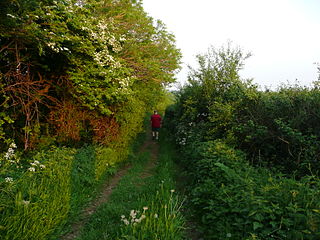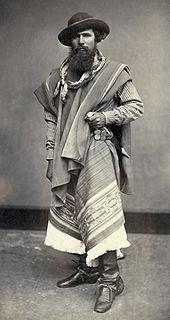 W
WTranshumance is a type of pastoralism or nomadism, a seasonal movement of livestock between fixed summer and winter pastures. In montane regions, it implies movement between higher pastures in summer and lower valleys in winter. Herders have a permanent home, typically in valleys. Generally only the herds travel, with a certain number of people necessary to tend them, while the main population stays at the base. In contrast, horizontal transhumance is more susceptible to being disrupted by climatic, economic, or political change.
 W
WAlpine transhumance is transhumance as practiced in the Alps, that is, a seasonal droving of grazing livestock between the valleys in winter and the high mountain pastures in summer. Transhumance is a traditional practice that has shaped much of the landscape in the Alps, as without it, most areas below 2,000 m (6,600 ft) would be forests. While tourism and industry contribute today much to Alpine economy, seasonal migration to high pastures is still practiced in Bavaria, Austria, Slovenia, Italy and Switzerland, except in their most frequented tourist centers. In some places, cattle are taken care of by local farmer families who move to higher places. In others, this job is for herdsmen who are employees of the cooperative owning the pastures.
 W
WAltitudinal migration is a short-distance animal migration from lower altitudes to higher altitudes and back. It is commonly thought to happen in response to climate and food availability changes as well as increasingly due to anthropogenic influence. These migrations can occur both during reproductive and non-reproductive seasons. Altitudinal avian migration is common, and can also be found in other vertebrates, and can be seen in some invertebrates.
 W
WBaita is a term used mainly in Italy and France to refer to small dwellings of the central and western Alps. This word is found from the Lepontine to the Maritime alpine sections.
 W
WA bothy is a basic shelter, usually left unlocked and available for anyone to use free of charge. It was also a term for basic accommodation, usually for gardeners or other workers on an estate. Bothies are found in remote mountainous areas of Scotland, Northern England, Northern Ireland, Wales and the Isle of Man. They are particularly common in the Scottish Highlands, but related buildings can be found around the world. A bothy was also a semi-legal drinking den in the Isle of Lewis. These, such as Bothan Eòrapaidh, were used until recent years as gathering points for local men and were often situated in an old hut or caravan.
 W
WA cattle drive is the process of moving a herd of cattle from one place to another, usually moved and herded by cowboys on horses.
 W
WCattle drives were a major economic activity in the 19th and early 20th century American West, particularly between 1850s and 1910s. In this period, 27 million cattle were driven from Texas to railheads in Kansas, for shipment to stockyards in Louisiana and points east. The long distances covered, the need for periodic rests by riders and animals, and the establishment of railheads led to the development of "cow towns" across the frontier.
 W
WA drover in Australia is a person, typically an experienced stockman, who moves livestock, usually sheep, cattle, and horses "on the hoof" over long distances. Reasons for droving may include: delivering animals to a new owner's property, taking animals to market, or moving animals during a drought in search of better feed and/or water or in search of a yard to work on the livestock. The drovers who covered very long distances to open up new country were known as "overlanders".
 W
WA drovers' road, drove [road] or droveway is a route for droving livestock on foot from one place to another, such as to market or between summer and winter pasture. Many drovers' roads were ancient routes of unknown age; others are known to date back to medieval or more recent times.
 W
WDroving is the practice of walking livestock over long distances. Droving stock to market—usually on foot and often with the aid of dogs—has a very long history in the Old World. An owner might entrust an agent to deliver stock to market and bring back the proceeds. There has been droving since people in cities found it necessary to source food from distant supplies.
 W
WA gaucho or gaúcho is a skilled horseman, reputed to be brave and unruly. The gaucho is a symbol in Argentina, Uruguay and Rio Grande do Sul state, southern Brazil, but is also a strong culture in Paraguay and Bolivia. Gauchos became greatly admired and renowned in legends, folklore and literature and became an important part of their regional cultural tradition. Beginning late in the 19th century, after the heyday of the gauchos, they were celebrated by South American writers.
 W
WA huaso is a Chilean countryman and skilled horseman, similar to the American cowboy or Mexican charro, the gaucho of Argentina, Uruguay and Rio Grande Do Sul and the Australian stockman. A female huaso is called a huasa, although the term china is far more commonly used for his wife or sweetheart, whose dress can be seen in cueca dancing. Huasos are found all over Central and Southern Chile while the Aysén and Magallanes Region sheep raisers are gauchos. The major difference between the huaso and the gaucho is that huasos are involved in farming as well as cattle herding.
 W
WPannage is the practice of releasing livestock-pigs in a forest, so that they can feed on fallen acorns, beechmast, chestnuts or other nuts. Historically, it was a right or privilege granted to local people on common land or in royal forests.
 W
WThe reindeer, also known as the caribou in North America, is a species of deer with circumpolar distribution, native to Arctic, sub-Arctic, tundra, boreal, and mountainous regions of northern Europe, Siberia, and North America. This includes both sedentary and migratory populations. Rangifer herd size varies greatly in different geographic regions. The Taimyr herd of migrating Siberian tundra reindeer in Russia is the largest wild reindeer herd in the world, varying between 400,000 and 1,000,000. What was once the second largest herd is the migratory boreal woodland caribou George River herd in Canada, with former variations between 28,000 and 385,000. As of January 2018, there are fewer than 9,000 animals estimated to be left in the George River herd, as reported by the Canadian Broadcasting Corporation. The New York Times reported in April 2018 of the disappearance of the only herd of southern mountain caribou in the contiguous United States with an expert calling it "functionally extinct" after the herd's size dwindled to a mere three animals.
 W
WSeasonal animal migration is very common in agricultural cycles. It includes migrations such as moving sheep or cattle to higher elevations during summer to escape the heat and find more forage. Human labor often moves with fruit harvest or to other crops that require manual picking.
 W
WA shieling, also spelt sheiling, shealing and sheeling, is a hut, or collection of huts, once common in wild or lonely places in the hills and mountains of Scotland and northern England. The word is also used for a mountain pasture for the grazing of cattle in summer, implying transhumance between there and a valley settlement in winter.
 W
WIn the crop growing season, transhumance is practised on a broad scale in the northern Ethiopian highlands, as farmland and its stubble can no longer be accessed by livestock.
 W
WThe Vaqueiros de Alzada are a northern Spanish nomadic people in the mountains of Asturias and León, who traditionally practice transhumance, i.e. moving seasonally with cattle.
 W
WYaylak is a Turkic term meaning "summer highland pasture". The converse term is gishlag, a winter pasture. The latter one gave rise to the term kishlak for rural settlements in Central Asia. Transcriptions of the term include yaylak, yaylaq, یایلاق, ailoq, jaylaw, or jayloo, and yeylāq (Persian).